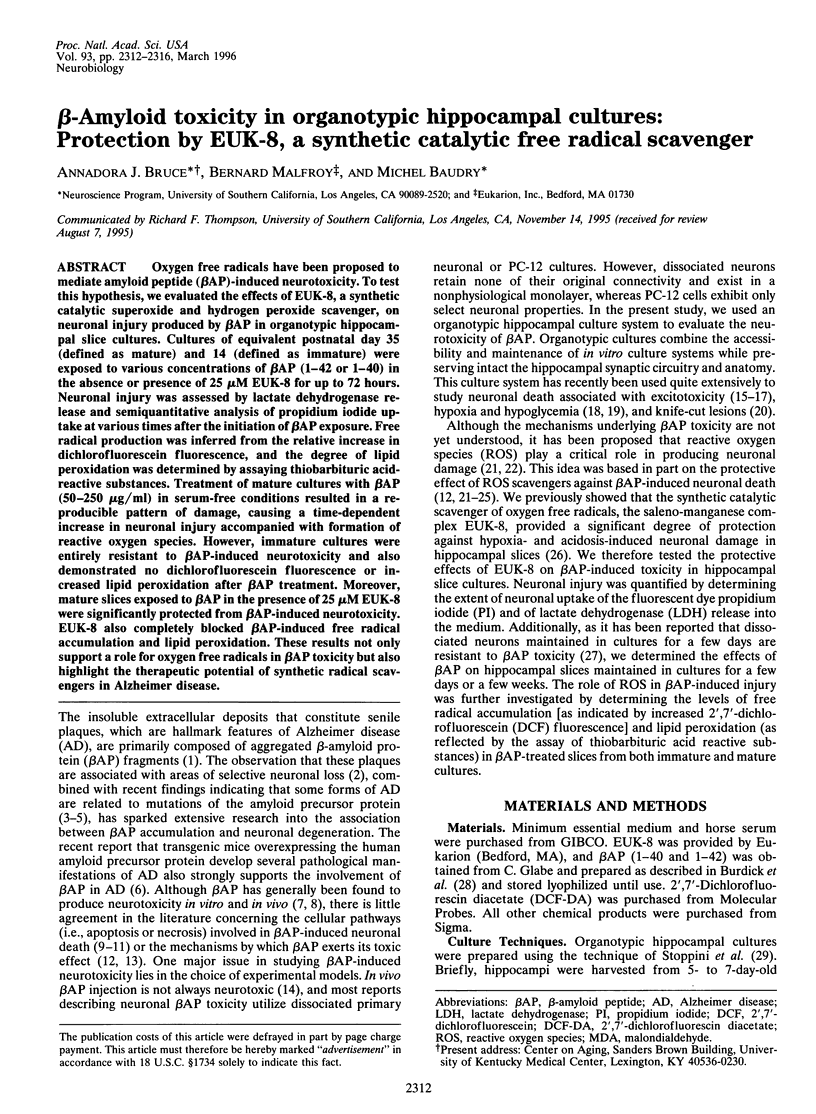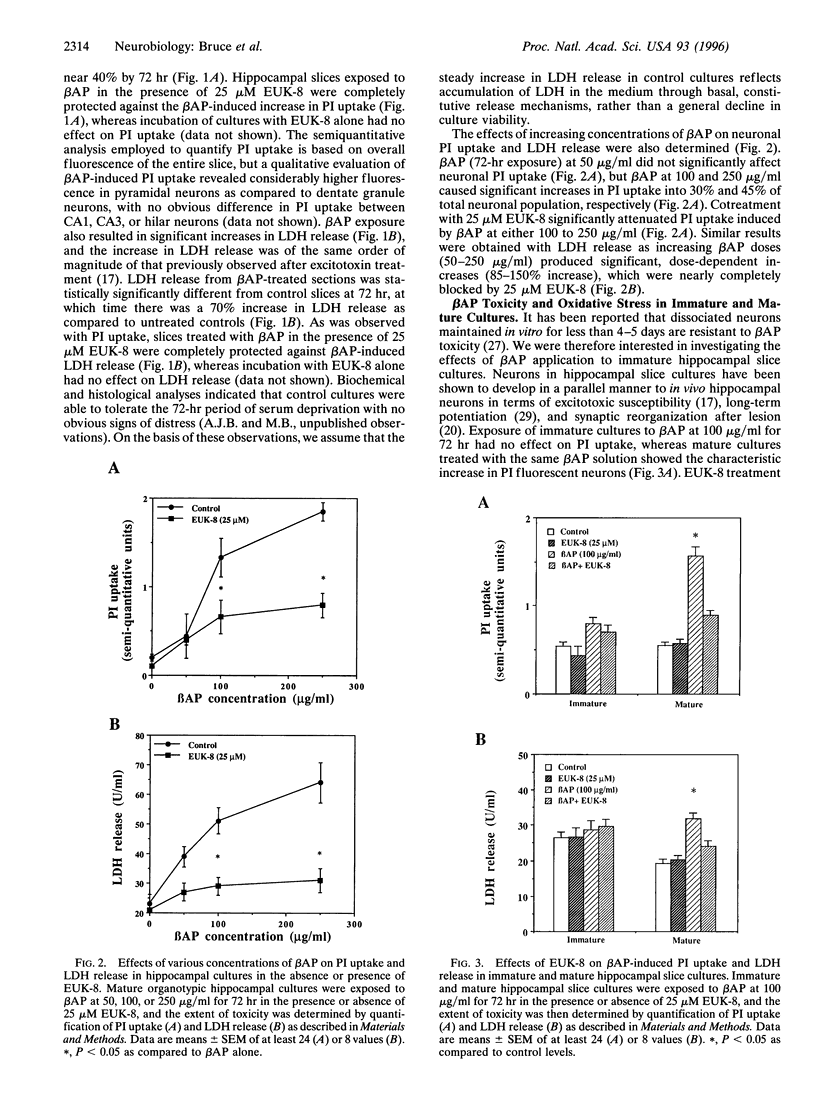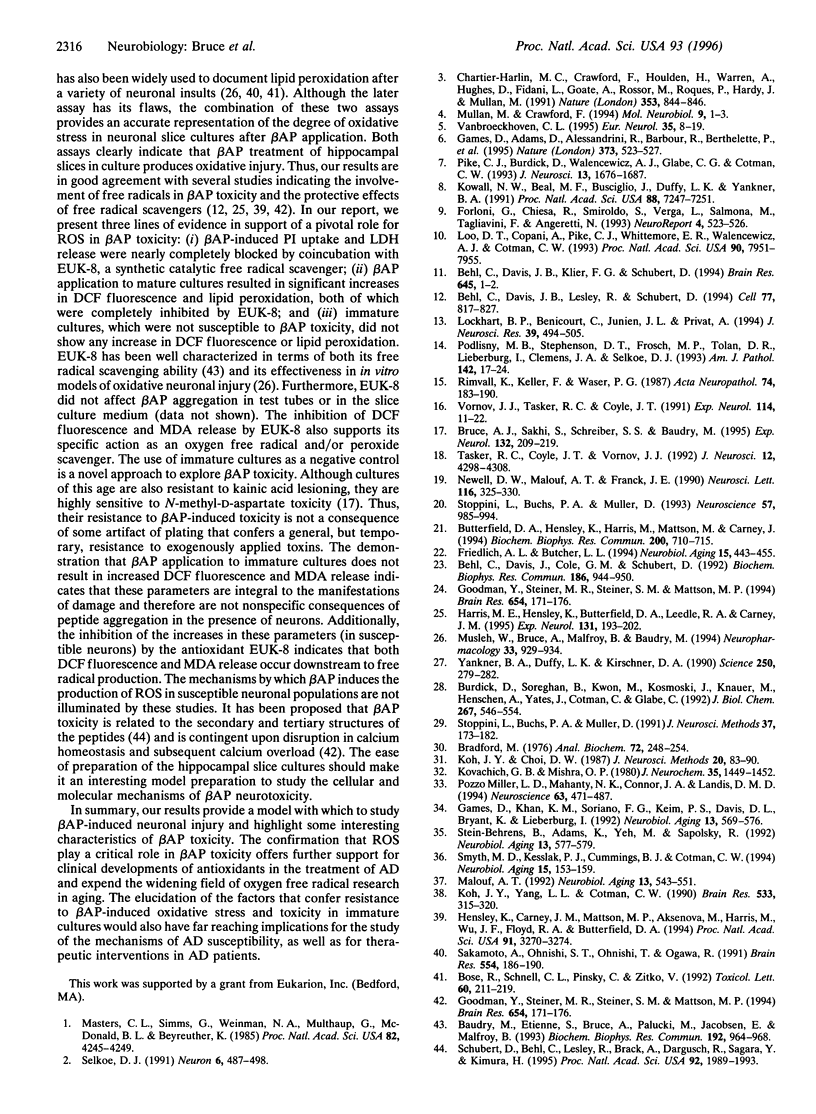Abstract
Oxygen free radicals have been proposed to mediate amyloid peptide (beta-AP)-induced neurotoxicity. To test this hypothesis, we evaluated the effects of EUK-8, a synthetic catalytic superoxide and hydrogen peroxide scavenger, on neuronal injury produced by beta-AP in organotypic hippocampal slice cultures. Cultures of equivalent postnatal day 35 (defined as mature) and 14 (defined as immature) were exposed to various concentrations of beta-AP (1-42 or 1-40) in the absence or presence of 25 microM EUK-8 for up to 72 hours. Neuronal injury was assessed by lactate dehydrogenase release and semiquantitative analysis of propidium iodide uptake at various times after the initiation of beta-AP exposure. Free radical production was inferred from the relative increase in dichlorofluorescein fluorescence, and the degree of lipid peroxidation was determined by assaying thiobarbituric acid-reactive substances. Treatment of mature cultures with beta-AP (50-250 microg/ml) in serum-free conditions resulted in a reproducible pattern of damage, causing a time-dependent increase in neuronal injury accompanied with formation of reactive oxygen species. However, immature cultures were entirely resistant to beta-AP-induced neurotoxicity and also demonstrated no dichlorofluorescein fluorescence or increased lipid peroxidation after beta-AP treatment. Moreover, mature slices exposed to beta-AP in the presence of 25 microM EUK-8 were significantly protected from beta-AP-induced neurotoxicity. EUK-8 also completely blocked beta-AP-induced free radical accumulation and lipid peroxidation. These results not only support a role for oxygen free radicals in beta-AP toxicity but also highlight the therapeutic potential of synthetic radical scavengers in Alzheimer disease.
Full text
PDF




Selected References
These references are in PubMed. This may not be the complete list of references from this article.
- Baudry M., Etienne S., Bruce A., Palucki M., Jacobsen E., Malfroy B. Salen-manganese complexes are superoxide dismutase-mimics. Biochem Biophys Res Commun. 1993 Apr 30;192(2):964–968. doi: 10.1006/bbrc.1993.1509. [DOI] [PubMed] [Google Scholar]
- Behl C., Davis J. B., Lesley R., Schubert D. Hydrogen peroxide mediates amyloid beta protein toxicity. Cell. 1994 Jun 17;77(6):817–827. doi: 10.1016/0092-8674(94)90131-7. [DOI] [PubMed] [Google Scholar]
- Behl C., Davis J., Cole G. M., Schubert D. Vitamin E protects nerve cells from amyloid beta protein toxicity. Biochem Biophys Res Commun. 1992 Jul 31;186(2):944–950. doi: 10.1016/0006-291x(92)90837-b. [DOI] [PubMed] [Google Scholar]
- Bose R., Schnell C. L., Pinsky C., Zitko V. Effects of excitotoxins on free radical indices in mouse brain. Toxicol Lett. 1992 Apr;60(2):211–219. doi: 10.1016/0378-4274(92)90276-p. [DOI] [PubMed] [Google Scholar]
- Bradford M. M. A rapid and sensitive method for the quantitation of microgram quantities of protein utilizing the principle of protein-dye binding. Anal Biochem. 1976 May 7;72:248–254. doi: 10.1016/0003-2697(76)90527-3. [DOI] [PubMed] [Google Scholar]
- Bruce A. J., Sakhi S., Schreiber S. S., Baudry M. Development of kainic acid and N-methyl-D-aspartic acid toxicity in organotypic hippocampal cultures. Exp Neurol. 1995 Apr;132(2):209–219. doi: 10.1016/0014-4886(95)90026-8. [DOI] [PubMed] [Google Scholar]
- Burdick D., Soreghan B., Kwon M., Kosmoski J., Knauer M., Henschen A., Yates J., Cotman C., Glabe C. Assembly and aggregation properties of synthetic Alzheimer's A4/beta amyloid peptide analogs. J Biol Chem. 1992 Jan 5;267(1):546–554. [PubMed] [Google Scholar]
- Butterfield D. A., Hensley K., Harris M., Mattson M., Carney J. beta-Amyloid peptide free radical fragments initiate synaptosomal lipoperoxidation in a sequence-specific fashion: implications to Alzheimer's disease. Biochem Biophys Res Commun. 1994 Apr 29;200(2):710–715. doi: 10.1006/bbrc.1994.1508. [DOI] [PubMed] [Google Scholar]
- Chartier-Harlin M. C., Crawford F., Houlden H., Warren A., Hughes D., Fidani L., Goate A., Rossor M., Roques P., Hardy J. Early-onset Alzheimer's disease caused by mutations at codon 717 of the beta-amyloid precursor protein gene. Nature. 1991 Oct 31;353(6347):844–846. doi: 10.1038/353844a0. [DOI] [PubMed] [Google Scholar]
- Forloni G., Chiesa R., Smiroldo S., Verga L., Salmona M., Tagliavini F., Angeretti N. Apoptosis mediated neurotoxicity induced by chronic application of beta amyloid fragment 25-35. Neuroreport. 1993 May;4(5):523–526. doi: 10.1097/00001756-199305000-00015. [DOI] [PubMed] [Google Scholar]
- Friedlich A. L., Butcher L. L. Involvement of free oxygen radicals in beta-amyloidosis: an hypothesis. Neurobiol Aging. 1994 Jul-Aug;15(4):443–455. doi: 10.1016/0197-4580(94)90076-0. [DOI] [PubMed] [Google Scholar]
- Games D., Adams D., Alessandrini R., Barbour R., Berthelette P., Blackwell C., Carr T., Clemens J., Donaldson T., Gillespie F. Alzheimer-type neuropathology in transgenic mice overexpressing V717F beta-amyloid precursor protein. Nature. 1995 Feb 9;373(6514):523–527. doi: 10.1038/373523a0. [DOI] [PubMed] [Google Scholar]
- Games D., Khan K. M., Soriano F. G., Keim P. S., Davis D. L., Bryant K., Lieberburg I. Lack of Alzheimer pathology after beta-amyloid protein injections in rat brain. Neurobiol Aging. 1992 Sep-Oct;13(5):569–576. doi: 10.1016/0197-4580(92)90057-5. [DOI] [PubMed] [Google Scholar]
- Goodman Y., Steiner M. R., Steiner S. M., Mattson M. P. Nordihydroguaiaretic acid protects hippocampal neurons against amyloid beta-peptide toxicity, and attenuates free radical and calcium accumulation. Brain Res. 1994 Aug 15;654(1):171–176. doi: 10.1016/0006-8993(94)91586-5. [DOI] [PubMed] [Google Scholar]
- Goodman Y., Steiner M. R., Steiner S. M., Mattson M. P. Nordihydroguaiaretic acid protects hippocampal neurons against amyloid beta-peptide toxicity, and attenuates free radical and calcium accumulation. Brain Res. 1994 Aug 15;654(1):171–176. doi: 10.1016/0006-8993(94)91586-5. [DOI] [PubMed] [Google Scholar]
- Harris M. E., Hensley K., Butterfield D. A., Leedle R. A., Carney J. M. Direct evidence of oxidative injury produced by the Alzheimer's beta-amyloid peptide (1-40) in cultured hippocampal neurons. Exp Neurol. 1995 Feb;131(2):193–202. doi: 10.1016/0014-4886(95)90041-1. [DOI] [PubMed] [Google Scholar]
- Hensley K., Carney J. M., Mattson M. P., Aksenova M., Harris M., Wu J. F., Floyd R. A., Butterfield D. A. A model for beta-amyloid aggregation and neurotoxicity based on free radical generation by the peptide: relevance to Alzheimer disease. Proc Natl Acad Sci U S A. 1994 Apr 12;91(8):3270–3274. doi: 10.1073/pnas.91.8.3270. [DOI] [PMC free article] [PubMed] [Google Scholar]
- Itzhaki R. F. Possible factors in the etiology of Alzheimer's disease. Mol Neurobiol. 1994 Aug-Dec;9(1-3):1–13. doi: 10.1007/BF02816099. [DOI] [PubMed] [Google Scholar]
- Koh J. Y., Choi D. W. Quantitative determination of glutamate mediated cortical neuronal injury in cell culture by lactate dehydrogenase efflux assay. J Neurosci Methods. 1987 May;20(1):83–90. doi: 10.1016/0165-0270(87)90041-0. [DOI] [PubMed] [Google Scholar]
- Koh J. Y., Yang L. L., Cotman C. W. Beta-amyloid protein increases the vulnerability of cultured cortical neurons to excitotoxic damage. Brain Res. 1990 Nov 19;533(2):315–320. doi: 10.1016/0006-8993(90)91355-k. [DOI] [PubMed] [Google Scholar]
- Kovachich G. B., Mishra O. P. Lipid peroxidation in rat brain cortical slices as measured by the thiobarbituric acid test. J Neurochem. 1980 Dec;35(6):1449–1452. doi: 10.1111/j.1471-4159.1980.tb09022.x. [DOI] [PubMed] [Google Scholar]
- Kowall N. W., Beal M. F., Busciglio J., Duffy L. K., Yankner B. A. An in vivo model for the neurodegenerative effects of beta amyloid and protection by substance P. Proc Natl Acad Sci U S A. 1991 Aug 15;88(16):7247–7251. doi: 10.1073/pnas.88.16.7247. [DOI] [PMC free article] [PubMed] [Google Scholar]
- Lockhart B. P., Benicourt C., Junien J. L., Privat A. Inhibitors of free radical formation fail to attenuate direct beta-amyloid25-35 peptide-mediated neurotoxicity in rat hippocampal cultures. J Neurosci Res. 1994 Nov 1;39(4):494–505. doi: 10.1002/jnr.490390416. [DOI] [PubMed] [Google Scholar]
- Loo D. T., Copani A., Pike C. J., Whittemore E. R., Walencewicz A. J., Cotman C. W. Apoptosis is induced by beta-amyloid in cultured central nervous system neurons. Proc Natl Acad Sci U S A. 1993 Sep 1;90(17):7951–7955. doi: 10.1073/pnas.90.17.7951. [DOI] [PMC free article] [PubMed] [Google Scholar]
- Malouf A. T. Effect of beta amyloid peptides on neurons in hippocampal slice cultures. Neurobiol Aging. 1992 Sep-Oct;13(5):543–551. doi: 10.1016/0197-4580(92)90054-2. [DOI] [PubMed] [Google Scholar]
- Masters C. L., Simms G., Weinman N. A., Multhaup G., McDonald B. L., Beyreuther K. Amyloid plaque core protein in Alzheimer disease and Down syndrome. Proc Natl Acad Sci U S A. 1985 Jun;82(12):4245–4249. doi: 10.1073/pnas.82.12.4245. [DOI] [PMC free article] [PubMed] [Google Scholar]
- Musleh W., Bruce A., Malfroy B., Baudry M. Effects of EUK-8, a synthetic catalytic superoxide scavenger, on hypoxia- and acidosis-induced damage in hippocampal slices. Neuropharmacology. 1994 Jul;33(7):929–934. doi: 10.1016/0028-3908(94)90191-0. [DOI] [PubMed] [Google Scholar]
- Newell D. W., Malouf A. T., Franck J. E. Glutamate-mediated selective vulnerability to ischemia is present in organotypic cultures of hippocampus. Neurosci Lett. 1990 Aug 24;116(3):325–330. doi: 10.1016/0304-3940(90)90095-q. [DOI] [PubMed] [Google Scholar]
- Pike C. J., Burdick D., Walencewicz A. J., Glabe C. G., Cotman C. W. Neurodegeneration induced by beta-amyloid peptides in vitro: the role of peptide assembly state. J Neurosci. 1993 Apr;13(4):1676–1687. doi: 10.1523/JNEUROSCI.13-04-01676.1993. [DOI] [PMC free article] [PubMed] [Google Scholar]
- Podlisny M. B., Stephenson D. T., Frosch M. P., Tolan D. R., Lieberburg I., Clemens J. A., Selkoe D. J. Microinjection of synthetic amyloid beta-protein in monkey cerebral cortex fails to produce acute neurotoxicity. Am J Pathol. 1993 Jan;142(1):17–24. [PMC free article] [PubMed] [Google Scholar]
- Pozzo Miller L. D., Mahanty N. K., Connor J. A., Landis D. M. Spontaneous pyramidal cell death in organotypic slice cultures from rat hippocampus is prevented by glutamate receptor antagonists. Neuroscience. 1994 Nov;63(2):471–487. doi: 10.1016/0306-4522(94)90544-4. [DOI] [PubMed] [Google Scholar]
- Rimvall K., Keller F., Waser P. G. Selective kainic acid lesions in cultured explants of rat hippocampus. Acta Neuropathol. 1987;74(2):183–190. doi: 10.1007/BF00692850. [DOI] [PubMed] [Google Scholar]
- Sakamoto A., Ohnishi S. T., Ohnishi T., Ogawa R. Relationship between free radical production and lipid peroxidation during ischemia-reperfusion injury in the rat brain. Brain Res. 1991 Jul 19;554(1-2):186–192. doi: 10.1016/0006-8993(91)90187-z. [DOI] [PubMed] [Google Scholar]
- Schubert D., Behl C., Lesley R., Brack A., Dargusch R., Sagara Y., Kimura H. Amyloid peptides are toxic via a common oxidative mechanism. Proc Natl Acad Sci U S A. 1995 Mar 14;92(6):1989–1993. doi: 10.1073/pnas.92.6.1989. [DOI] [PMC free article] [PubMed] [Google Scholar]
- Selkoe D. J. The molecular pathology of Alzheimer's disease. Neuron. 1991 Apr;6(4):487–498. doi: 10.1016/0896-6273(91)90052-2. [DOI] [PubMed] [Google Scholar]
- Smyth M. D., Kesslak J. P., Cummings B. J., Cotman C. W. Analysis of brain injury following intrahippocampal administration of beta-amyloid in streptozotocin-treated rats. Neurobiol Aging. 1994 Mar-Apr;15(2):153–159. doi: 10.1016/0197-4580(94)90106-6. [DOI] [PubMed] [Google Scholar]
- Sribanditmongkol P., Sheu M. J., Tejwani G. A. Inhibition of morphine tolerance and dependence by diazepam and its relation to the CNS Met-enkephalin levels. Brain Res. 1994 May 9;645(1-2):1–12. doi: 10.1016/0006-8993(94)91631-4. [DOI] [PubMed] [Google Scholar]
- Stein-Behrens B., Adams K., Yeh M., Sapolsky R. Failure of beta-amyloid protein fragment 25-35 to cause hippocampal damage in the rat. Neurobiol Aging. 1992 Sep-Oct;13(5):577–579. doi: 10.1016/0197-4580(92)90058-6. [DOI] [PubMed] [Google Scholar]
- Stoppini L., Buchs P. A., Muller D. A simple method for organotypic cultures of nervous tissue. J Neurosci Methods. 1991 Apr;37(2):173–182. doi: 10.1016/0165-0270(91)90128-m. [DOI] [PubMed] [Google Scholar]
- Stoppini L., Buchs P. A., Muller D. Lesion-induced neurite sprouting and synapse formation in hippocampal organotypic cultures. Neuroscience. 1993 Dec;57(4):985–994. doi: 10.1016/0306-4522(93)90043-f. [DOI] [PubMed] [Google Scholar]
- Tasker R. C., Coyle J. T., Vornov J. J. The regional vulnerability to hypoglycemia-induced neurotoxicity in organotypic hippocampal culture: protection by early tetrodotoxin or delayed MK-801. J Neurosci. 1992 Nov;12(11):4298–4308. doi: 10.1523/JNEUROSCI.12-11-04298.1992. [DOI] [PMC free article] [PubMed] [Google Scholar]
- Van Broeckhoven C. L. Molecular genetics of Alzheimer disease: identification of genes and gene mutations. Eur Neurol. 1995;35(1):8–19. doi: 10.1159/000117083. [DOI] [PubMed] [Google Scholar]
- Vornov J. J., Tasker R. C., Coyle J. T. Direct observation of the agonist-specific regional vulnerability to glutamate, NMDA, and kainate neurotoxicity in organotypic hippocampal cultures. Exp Neurol. 1991 Oct;114(1):11–22. doi: 10.1016/0014-4886(91)90079-r. [DOI] [PubMed] [Google Scholar]
- Yankner B. A., Duffy L. K., Kirschner D. A. Neurotrophic and neurotoxic effects of amyloid beta protein: reversal by tachykinin neuropeptides. Science. 1990 Oct 12;250(4978):279–282. doi: 10.1126/science.2218531. [DOI] [PubMed] [Google Scholar]


